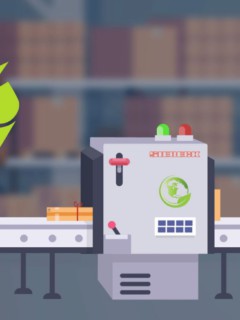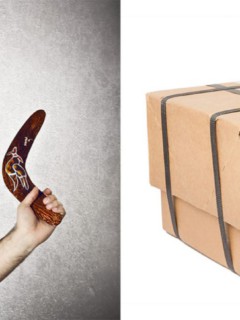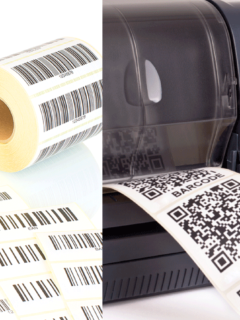Presenting in the office is not for everyone. Most people are fine with discussing a new workflow, the current status of a project or the various options for the trade fair stand with one or even two colleagues. However, if the number of people in the audience increases and the boss is sitting among them, the stress level also rises. For the less spontaneous among us, good preparation is the be-all and end-all. But there are certain traps lurking here:
Flipchart vs. PowerPoint
You have probably been an audience member at such a presentation often enough: The (presumably nervous) presenter clicks through a series of very elaborately designed PowerPoint slides, reading out what is there word for word in the worst case. Yawn. What you see is a vast amount of data that is already ready and waiting to be called up, so the presentation is a purely passive affair, eat or die, listener!
It’s quite different when you get the feeling that you are witnessing – or perhaps even participating in – the creation of a new and unique idea. A speaker who involves you, who may even graphically incorporate ideas from the audience into his presentation, using a rather simple tool after all:
The flipchart! It has a slightly backward, somewhat chaotic reputation, the flipchart. For brainstorming processes in smaller circles, yes, but for presentations? Absolutely, think many communication trainers, including Andreas Konzack. On his website, he explains the advantages of a flipchart presentation over a digital presentation:
Disadvantages of a purely digital presentation
- Dumbing down: We are completely saturated by the constant use of digital media
- Speaker in focus? The beamer’s sprinkling does not allow for any interaction.
- Brain in sleep mode: attention span drops drastically. Projector on, eyes closed
- Canned food: Instinctively, the audience knows that the presentation is standard fare for many
- Click and go: With the next mouse click, the information disappears into nirvana, it is no longer present
Advantages of a flipchart presentation
- Excitement: What is he doing? We break the visual habit
- Appreciation: You are doing something for your audience, exclusively in the here and now. This feeling of “he did that for me ” creates a bond.
- Perfect thought support, always present: What you need in the course of the presentation is also always visible to you
- Individual: You can meet the needs of your audience completely individually
So leave everything to chance? Be spontaneous?
No. While a brainstorming session actually involves jotting down ideas and bullet points on a flipchart or whiteboard, still in a richly disorganised and spontaneous manner, a planned presentation can be just as well prepared with a flipchart as a digital presentation. Start with a cover sheet, present your outline to the audience and simply practise the flow and drawings in advance. Consider, possibly with a “test audience”, what questions you can ask your audience. If you are clever, you can “provoke” exactly the desired objections and contributions by asking the right questions. Don’t be afraid of a few seconds of silence, they are difficult to endure, but they also build up tension. And if there is really no answer, give it yourself: “Let’s assume that it behaves like this…”.
The hardware: What materials do I need?
Good preparation also includes having all materials ready and checking them for functionality:
 The flipchart pad
The flipchart pad Schreibmaterial
Schreibmaterial Marking
MarkingArchiving flipchart sheets
A weak point of the flipchart presentation compared to the PowerPoint method is archiving and making the presentation available to the participants. Photograph the flipchart pages after the presentation, present on the whiteboard, ideally have a “photographer” in the audience to photograph the boards. Then combine the individual image files into a pdf file that you can send to the participants.
Detach the used flipchart sheets from the pad and roll them up. In a mailing tube, visibly labelled from the outside, a real archive is gradually created.
Prepare a good handout that the participants can take with them after the presentation. The handout can also be “scribbled” by hand and scanned if they need the presentation digitally.
In a presentation, the handout is basically a business card. It is taken to one’s desk after the presentation, it serves as a guide in meetings with colleagues or the boss. However, you should resist the temptation to simply print out the PowerPoint slides. Have you put a lot of effort into working out the relevant idea? Then a good handout must also work “on its own”, it must be able to convey your idea to third parties. Therefore, use complete sentences and (concise) flowing text. For the actual presentation, whether digital or on the flipchart, key points are recommended. The handout can even help here: It is easier to keep the presentation clear and free of text when you know that you can give the audience the contents of the presentation in writing in the handout.
What makes a good handout?
Of course, it is also the eye that makes the difference. So, in addition to preparing your presentation, you should also think about what you want to give your audience. A good and visually appealing cover sheet is as essential as good product packaging in the supermarket.
- The cover sheet: What is the focus of the presentation? What is the question? Little text: Perhaps you can find pictures that visualise the idea, the project or the topic on the cover sheet?
- The outline: Give a brief insight into the structure. In a multifaceted document, the outline with page references helps you to find your way around quickly.
- Main body: In the execution of your solution elaboration, subdivide into intermediate captions. This makes reading easier and helps you find your way around the document. If possible, present figures that support your thesis in charts, graphs or diagrams.
- Conclusion: Summarise your proposal for a solution, your recommendation for action or your view of the problem. If in doubt, one sentence is enough!
Bundle, staple, tack?
How do you turn a loose-leaf collection into a compact and presentable document? You should pay some attention to this point. The way you present your handout draws attention and appreciation to it. Sure, there are contents and occasions when stapling or stapling the sheets is quite sufficient. However, your documents are much more durable and of higher quality if you bind them, for example with a spiral binding. Binding spines give your documents a professional look and are easy to attach yourself with the help of a binding tool that allows you to both punch and bind. Use high-quality paper throughout the document and consider a cover sheet and spine with a high grammage (e.g. 250g/m²).














